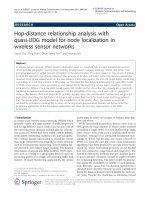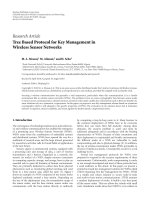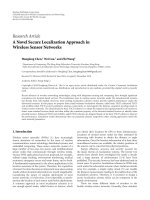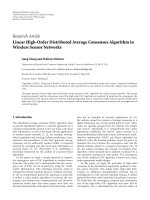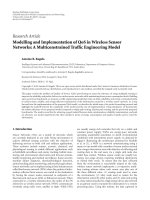Combinatorics based energy conservation methods in wireless sensor networks
Bạn đang xem bản rút gọn của tài liệu. Xem và tải ngay bản đầy đủ của tài liệu tại đây (749.04 KB, 161 trang )
COMBINATORICS-BASED ENERGY CONSERVATION
METHODS IN WIRELESS SENSOR NETWORKS
WONG YEW FAI
M.Eng., B.Eng,(Hons,), NUS
A THESIS SUBMITTED
FOR THE DEGREE OF DOCTOR OF PHILOSOPHY OF
ENGINEERING
DEPARTMENT OF ELECTRICAL & COMPUTER ENGINEERING
FACULTY OF ENGINEERING
NATIONAL UNIVERSITY OF SINGAPORE
i
COMBINATORICS-BASED ENERGY CONSERVATION
METHODS IN WIRELESS SENSOR NETWORKS
WONG YEW FAI
M.Eng., B.Eng,(Hons,), NUS
A THESIS SUBMITTED
FOR THE DEGREE OF DOCTOR OF PHILOSOPHY OF
ENGINEERING
DEPARTMENT OF ELECTRICAL & COMPUTER ENGINEERING
FACULTY OF ENGINEERING
NATIONAL UNIVERSITY OF SINGAPORE
ii
Acknowledgement
I would like to express my gratitude to Professor Lawrence Wong Wai Choong for
his kind supervision and guidance in my research work. I am grateful for his ideas,
thoughts, experience, suggestions and all the discussion time that has always made our
work an improvement from its original form. In particular, Professor Lawrence Wong
has been generously understanding and patience, for those times when my research
progress is slow due to my company work commitments.
I would also like to thank Dr Ngoh Lek Heng for his co-supervisory role in my
research work amidst his busy schedules at the Institute for Infocomm Research. His
detailed analysis and in-depth discussion over very specific parts of my research has no
doubt made progress faster and smoother. He has also suggested clear organization of
ideas and concepts that has made our work in every way, a significant improvement.
I am appreciative of Dr Wu Jian Kang, Institute for Infocomm Research, for his
experience and our discussions on the application aspect of sensor networks. He has
made insightful suggestions and comments to our work related to signal processing,
data fusion and particle filters. Dr Tele Tan, Curtin University of Technology, has also
contributed many ideas on the application aspects in the early days of this research
work. Similarly, I would also like to express my thanks to Dr Winston Seah Khoon
Guan, Institute for Infocomm Research, for sharing his experience in underwater
sensor networks and our discussions on wakeup schemes for underwater sensor
networks. My sincere appreciation also goes to Professor Tham Chen Khong and
Professor Vikram Srinivasan, National University of Singapore, for their kind review
of our work related to query-based sensor networks. They have shared a wealth of
useful comments and ideas in our discussions so that our formulations and concepts are
iii
elaborated clearly and unambiguously. My special thanks extend to Dr Jaya Shankar,
Institute for Infocomm Research, for his keen interest in all my research efforts and his
understanding whenever I need to manage between academic research work and
company research work.
I would like to thank Professor Chua Kee Chaing, Professor Soh Wee Seng and
once again Professor Tham Chen Khong for their invaluable comments and feedback
as panel members during my qualifying examinations.
I must also mention Mr Jean-Christopher Renaud for his contributions in our
implementation experiments using Crossbow motes and Miss Trina Kok for her help
on the classification of energy conservation schemes in the literature. Credit also goes
to Mr Dale Green, Teledyne-Benthos Inc., for his invaluable experiences and thoughts
on underwater sensor networks and the acoustic signaling challenges in real world
deployments. I am also thankful for the help I received from Mr J. Vedvyas in some of
the related demonstrations that we undertook.
Last but not least, credit must also go to Flossie and Oh Chew Ling for their
friendly assistance in organizing our biweekly meetings. Finally, I would like to thank
all that have directly or indirectly contributed to the fulfillment of our research work.
Wong Yew Fai
31 October 2007
iv
Table of Contents
ACKNOWLEDGEMENT II
TABLE OF CONTENTS IV
SUMMARY VI
LIST OF TABLES VII
LIST OF FIGURES VIII
CHAPTER 1: INTRODUCTION 10
1.1. WIRELESS SENSOR NETWORKS & THEIR KEY CHALLENGES 10
1.2. REAL WORLD IMPLEMENTATIONS OF SENSOR NETWORKS 11
1.3. RELATED WORK 12
1.3.1 EXISTING ENERGY-CONSERVATION WAKEUP SCHEMES 13
1.3.2 OTHER ENERGY-CONSERVATION METHODS IN SENSOR NETWORKS 18
1.4. MOTIVATION & CONTRIBUTIONS 23
1.5. ORGANIZATION OF THESIS 26
CHAPTER 2: COMBINATORICS-BASED WAKEUP SCHEME AND ITS
PROPERTIES 27
2.1. THE CYCLIC SYMMETRIC BLOCK DESIGN (CSBD) 27
2.1.1 SYMMETRIES OF CSBD 30
2.2. CHARACTERISTICS OF CSBD 32
2.3. ASYNCHRONOUS NEIGHBOUR DISCOVERY AND DATA TRANSMISSIONS 36
2.4. NETWORK CONNECTIVITY 37
2.5. IMPLEMENTATION COSTS 41
2.6. SUMMARY 42
CHAPTER 3: AGENT-BASED SENSOR NETWORKS 43
3.1. KEY DESIGN CONSIDERATIONS 44
3.1.1 SENSING COVERAGE 44
3.1.2 DELAY 48
3.1.3 SCHEDULE DIVERSITY 53
3.1.4 NODE LIFETIME 55
3.2. AGENT-BASED DATA FUSION FOR TARGET TRACKING 56
3.3. OVERCOMING THE PRIME POWER CONSTRAINT 60
3.4. APPLYING CSBD FOR TARGET TRACKING 60
3.4.1 SIMULATION RESULTS 62
3.5. TRACKING WAKEUP SCHEDULE FUNCTION (TWSF) 69
3.5.1 SIMULATION RESULTS 78
3.6. SUMMARY 80
CHAPTER 4: QUERY-BASED SENSOR NETWORKS 82
v
4.1. KEY DESIGN CONSIDERATIONS 82
4.1.1 QUERY WAITING DELAYS 82
4.2. RELAXATION OF CONSTRAINTS 91
4.3. COMPLEMENTING THE AGENT-BASED SYSTEM 93
4.4. MOBILE SENSOR NODES 96
4.5. DATABASE WAKEUP SCHEDULE FUNCTION (DWSF) 97
4.5.1 SIMULATION RESULTS 97
4.5.2 IMPLEMENTATION EXPERIMENTAL RESULTS 109
4.6. SUMMARY 112
CHAPTER 5: AD-HOC AND SPARSE SENSOR NETWORKS 114
5.1. SCENARIOS FOR DEPLOYMENT OF AD HOC AND SPARSE NETWORKS 114
5.2. LIMITATIONS OF EXISTING WAKEUP SCHEMES 116
5.3. ADAPTIVE WAKEUP SCHEDULE FUNCTION (AWSF) 118
5.4. ASYNCHRONOUS NEIGHBOUR DISCOVERY 124
5.5. DATA TRANSMISSION AND AWSF MAINTENANCE 126
5.6. NETWORK CONNECTIVITY AND SENSING COVERAGE 127
5.7. OTHER PROPERTIES OF AWSF 129
5.8. AN APPLICATION OF AWSF 130
5.8.1 SIMULATION RESULTS 133
5.9. SUMMARY 138
CHAPTER 6: CONCLUSION AND FUTURE WORK 139
6.1. CONCLUSION 139
6.2. FUTURE WORK 140
REFERENCES 143
APPENDIX A – RELATED PUBLICATIONS 154
APPENDIX B – LIST OF DEFINITIONS, LEMMAS, THEOREMS, COROLLARIES
AND PROPERTIES 155
APPENDIX C – LIST OF COMMON ACRONYMS 159
vi
Summary
Wireless sensor networks have emerged as one of the new fields of research where
their potential applications may range widely from elderly healthcare, military defense,
wildlife monitoring, disaster recovery, construction safety monitoring, tsunami warning
systems, target tracking, intrusion detection and others. Owing to their relatively small
form factor and cheap manufacturing costs, sensors may be deployed in high density to
monitor an area of interest. One main challenge in deploying such wireless networks is
the energy scarcity problem since sensors are often powered only by regular batteries.
This energy conservation issue in sensor networks is paramount and complicated by
application requirements such as network connectivity, sensing coverage, information
delay, and implementation cost constraints, which are not all taken into account in the
existing literature. While energy expenditure in the network must be controlled, the
sensor network must still serve the purpose of the sensor network application.
We propose a class of deterministic wakeup schemes, the cyclic symmetric block
designs (CSBD), related to the field of Combinatorics. We consider important
requirements of sensor network applications and propose appropriate CSBD wakeup
schedules to conserve energy for each purpose. We describe the application of CSBD-
based schemes to three main categories of sensor networks – Agent-based sensor
networks, Query-based sensor networks, and Ad-hoc and sparse sensor networks. Each
category of sensor networks operates with different requirements/assumptions and we
provide detailed analysis and discussion on the benefits of CSBD in our work. We further
support and justify our claims with comprehensive simulation studies and selected
implementation results.
Keywords:
Combinatorics, Energy Conservation, Energy Saving, Wakeup Scheme, Wireless
Sensor Networks, Adaptation
vii
List of Tables
Table 1: Simulation parameters for target tracking 63
Table 2: Simulation parameters for TWSF Simulations 78
Table 3: Comparing target tracking accuracies (TTA) and identification errors (PFN)
across different wakeup schemes. Both the proposed Two-tier scheme and RAW has a
network lifetime that is about 8 times longer than PECAS when the comparisons are
made. 106
Table 4: Target tracking accuracies (TTA) and identification errors (PFN) for the
proposed Two-tier scheme when its network lifetime is 4 times, 8 times and 12 times
that of PECAS. 107
Table 5: Comparing CD queries and AD queries for the Two-tier BTC + DWSF
scheme across different performance metrics. 108
Table 6: Ratio of energy spent by a mote with CSBD over the energy spent by a mote
that is always “Awake”. 111
Table 7: Comparing Network Lifetimes (in default units) 137
viii
List of Figures
Figure 1: The Cyclic Symmetric (13,4,1) Block Design with k = 3. 29
Figure 2: Illustrating geometric symmetry in the Cyclic Symmetric (13,4,1) design.
Lines/Curves represent schedules and dots represent time slots. Numbers correspond
to time slot numbers in Figure 1. 29
Figure 3: Illustrating geometric symmetry. (i) The Cyclic Symmetric (7,3,1). (ii)
Symmetry of (7,3,1). (iii) The Cyclic Symmetric (21,5,1). (iv) Symmetry of (21,5,1). 31
Figure 4: Illustrating BEACON messages as discussed in Zheng’s work [27] for
neighbour discovery. 36
Figure 5: Illustrating asynchronous neighbour discovery with misaligned time slots.40
Figure 6: (a) LNWT = 12 T
slot
. (b) LNWT = 4 T
slot
. 49
Figure 7: Illustrating the proof of a tracking delay bound. 50
Figure 8: Illustrating the proof of a third hop node outside 4Rs for α = 3. 52
Figure 9: Collision Probability for different values of k with R
C
=150m, p
tx
=20%. 54
Figure 10: Theoretical node lifetime bound for different application time resolution
requirements with N
hop
=1. 56
Figure 11: Delay Performance 64
Figure 12: Network Lifetime Performance for R
C
= 150m. 65
Figure 13: Network Lifetimes and approximate lower bound for different T
res
values.
66
Figure 14: Loss of Continuity in Tracking (LCT) for different average target speeds
68
Figure 15: Distributed 1-hop Agent TWSF Algorithm 72
Figure 16: An example (13,4,1) network. 75
Figure 17: TWSF-Enabled Schedules using example in Figure 16. 77
Figure 18: Delay Performance Comparison 79
Figure 19: Illustrating different possible solutions to the same CD query request in a
(7,3,1) design. 89
Figure 20: (a) Delay and (b) Energy Behaviours for varying CD user query lengths
with the cyclic symmetric (7,3,1) design. 90
Figure 21: Illustrating BTC and DWSF nodes in a two-tier solution for a target
tracking application. 95
Figure 22: Delay performance for different wakeup schemes for different packet
types. In the simulations, the network lifetimes of all three schemes are within a 5%
difference from each other. 103
Figure 23: Tradeoff between network lifetime and packet delay for the proposed two-
tier BTC + DWSF scheme, with and without energy balance algorithm ESAP (section
4.4). 104
Figure 24: Query delays for slot times. T
slot
= 2 seconds 109
ix
Figure 25: Query Delay for Queries of Different Query Lengths. T
slot
= 2 seconds. 111
Figure 26: Illustrating The “Lonely Node Problem” in Sparse Networks. 118
Figure 27: (a) AWSF pruning where crosses indicate active time slots that are pruned
off; and (b) BRS scheme for a cyclic symmetric (13,4,1)-design. Integers indicate the
number of active slot overlaps with neighbour nodes, or equivalently reassignment
priorities. Light-gray boxes refer to randomly reassigned slots amongst slots with the
same non-zero priority number in the schedule, dark-gray boxes refer to either
original active slots or reassigned slots with unique priority numbers in the schedule,
and black boxes refer to slots reassigned based on a special case. 120
Figure 28: (a) Illustrating Slot Mis-alignment and loss of bidirectional C-F link for
the worst case of one active slot overlap between schedules. (b) Illustrating Slot Mis-
alignment and restoration of bidirectional C-F link for the worst case of one active
slot overlap between schedules. 125
Figure 29: Comparing network connectivity for AWSF-BRS and CSBD at time
snapshots t=3, 4 and 10. Awake nodes are coloured grey and Sleep nodes are coloured
white. Both schemes have the same duty cycle over one cycle. All nodes in AWSF
always find a neighbour to communicate when in wakeup mode. 128
Figure 30: Potential UWSN for seismic imaging of underwater oil fields 132
Figure 31: Comparing the delay results across different routing wakeup schemes. The
delay bound is a loose bound assuming the worst-case possible number of hops in the
network. All schemes use the same node duty cycle of about 12.4%. 134
Figure 32a: Comparing energy overheads for different routing wakeup schemes. . 136
Figure 32b: Comparing delay for different routing wakeup schemes. 136
10
Chapter 1: Introduction
1.1. Wireless Sensor Networks & Their Key Challenges
The widespread interest in wireless sensor networks research in recent years may be
attributed to the possibility of such networks emerging as a disruptive force in shaping the
way many activities are carried out. With the ability to sense, store and communicate a
host of different kinds of information about the environment from seismic data to air
quality records to electromagnetic fluctuations, the potential impact of sensor networks on
many different disciplinary fields can be considerably diverse and huge. With further
advancements in reducing the form factors of such sensors, the realistic deployment size
of sensor networks can also be predictably large.
While sensor networks can be applied to solve many different problems across
various different platforms, several challenges arise from this relatively new domain of
research. Being small in size and wireless, most sensors are powered only by batteries,
and energy becomes a scarce resource in such networks. The issue of managing or
controlling the use of energy for the sensors’ operations is principally important. The
physical deployment of sensors to sense the environment presents itself a sensing
coverage and deployment density problem. This coverage problem is further complicated
by sensors optionally switching themselves off during certain periods to conserve energy.
Depending on the application, a sufficiently good coverage of the intended environment
under monitoring may be required. With sensors deployed in large numbers, each
collecting vast amounts of data individually, organization of sensor information and data
flow within the network becomes another huge challenge. Since sensors are often
scattered randomly during deployment, efficient and cost-effective localization
techniques for individual sensors to discover either their absolute or relative positions in
the sensing field may also be necessary. Other main challenges may include security
11
issues, routing issues and collision avoidance issues related to deploying sensor networks
in large numbers or in high density scenarios.
1.2. Real world Implementations of Sensor Networks
The most commonly known and probably the de-facto sensor network platform, is the
Berkeley family of motes from Crossbow Technology Inc. [1]. Other competing
platforms include the Cricket [2], the WINS Sensoria nodes [3] and the Specknet [5, 4]
systems. The influence of such sensor networks on applications is wide-ranging, and this
section can only highlight a fraction of the many real-world applications of sensor
networks.
Collaborations between Fujitsu laboratories, Venturi Wireless and San Jose State
University [6] report on a sensor networks prototype developed for the purpose of elderly
healthcare. The aim is to monitor the medication conditions of elderly patients by
integrating Radio Frequency Identification (RFID) technology with sensor network
technology. Similarly, the collaboration between Motion Analysis Laboratory at the
Spaulding Rehabilitation Hospital and Harvard University [7, 8] are developing a sensor
board for monitoring limb movements and muscle activity of stroke patients during
rehabilitation exercise.
The Sensor Networks Research Group at the University of Wisconsin [9] successfully
deployed a sensor network at 29 Palms, California to detect and classify signals from
moving military targets. In their experiments, acoustic, seismic and passive infrared
signals were collected from two different types of military vehicles – the Assault
Amphibian Vehicle (AAV) and the Dragon Wagon (DW). The University of California at
Berkeley also designed and deployed 100 sensors in a 400m
2
outdoor sensing field for the
purpose of vehicle tracking and intruder interception.
Sensor networks have also been applied to habitat and wildlife monitoring.
Noticeably, the deployment at Great Duck Island [10] with about 200 sensors measure
12
basic environmental parameters such as light, pressure, temperature and humidity
information to serve as long-term baseline data for further work. At James Reserve,
sensors are also deployed to monitor the ecosystem for understanding the response of
vegetation to climate changes. The collaboration between Intel Corporation and the
University of California at Berkeley also developed a habitat monitoring kit for biologists
and researchers to reliably collect data from previously inaccessible locations.
Recently, the building and construction sector has also developed interests in
employing wireless sensing technologies to monitor the health of structural beams during
construction and excavations. As it is a legal requirement in many countries for
construction companies to sufficiently monitor supporting beams in any construction
activity, the current cabled-sensing solutions that are in use are costly. In-lay cables are
expensive and are commonly severed accidentally in work sites thereby incurring
frustrating schedule delays and costly repair overheads. Moreover, in muddy terrains and
deep troughs, cabling becomes impossible and manual monitoring by a worker becomes
necessary. Manual monitoring involves manual recording of long strings of data and
identification numbers that are often erred by human mistakes.
Researchers from the University of Pittsburgh [11] are also hoping to develop a
network of ocean floor mobile sensors to complement existing deep water tsunami
detection buoys in the Pacific and Indian Oceans. By offering greater coverage of the
ocean floor, detections that are previously missed by the more expensive deep water
buoys that are spaced far apart, may be picked up by the cheaper sensor network that is in
place.
1.3. Related Work
As real world sensor network deployment is becoming a trend and reality, the key
problem of conserving energy in sensors has encouraged many researchers to devise
13
various solutions based upon different assumptions. In this section, we provide a review
of some of these related works in energy conservation techniques.
1.3.1 Existing Energy-Conservation Wakeup Schemes
The Random Wakeup Solution
Paruchuri et. al. proposed the Random Asynchronous Wakeup (RAW) scheme [
12]
where each node randomly wakes up once in every time frame, be awake for a
predetermined fixed time and then sleeps again. Data is sent from a node N to a
forwarding set of neighbouring nodes so that delay can be minimized. The forwarding set
includes all nodes that lie in the area intersection of the circular transmission range of
node N and the circular range of a certain radius centered about the destination node. It is
reported that for 10 nodes in the forwarding set, a per-hop packet loss rate of 18% is
expected. In their work, a node deployment density of at least 10/R
C
2
is used where R
C
is
the communication radius of nodes. This also represents the frequency at which nodes
wake up but find no other nodes in communication range to transmit or forward data.
However, wakeup schedules are time-asynchronous owing to the randomness in the
solution. Delays incurred are small because of numerous choices in forwarding nodes in
the forwarding sets.
Kumar et. al. proposed the Random Independent Scheduling (RIS) [
13] where time is
divided into cycles using some time synchronization method. At the start of each cycle,
every node independently takes on an “Awake” mode with probability p and “Sleep”
mode with probability (1 – p). Therefore, RIS uses this parameter p to control network
lifetime. RIS also determines how nodes should be initially deployed to ensure
asymptotic m-coverage. In asymptotic m-coverage, the network is m-covered only when
the number of sensors deployed approaches infinity. However, although RIS has no
communication overheads and requires no location information, it does not address
connectivity issues and the problem of nodes waking up to find no communicable
14
neighbours is obvious. The scheme is also not robust against node failures and requires
expensive time-synchronization techniques that inhibit scalability.
The Connected Dominating Set Wakeup Solution
A connected dominating set (CDS) of a network graph G(V, E) with nodes V and
links E, is a set of nodes V’ ⊂ V such that every node not in V’ is connected to at least one
node in V’ by some link in E; and the subgraph induced by V’ is also connected. CDS
sensor nodes are switched to the “Awake” or “On” state while non-CDS sensor nodes are
put to the “Sleep” or “Off” state. The CDS in a network therefore acts as a “backbone” of
nodes where information may be sent from one node to another across the network in
relatively short time. To reduce energy consumption as much as possible, many
algorithms aim to elect a minimum connected dominating set (MCDS), i.e. a CDS with
minimum cardinality. Election of nodes to form the MCDS is an NP-complete problem,
but in practice, heuristics may be used to form a CDS that approximates the MCDS.
Centralized CDS election algorithms such as that by Guha and Khuller (GH) [13] can
theoretically be implemented in a distributed manner, albeit with higher control overhead
in exchanging neighbour information. Topology Management by Priority Ordering,
TMPO [14] is a distributed algorithm that elects CDS nodes in an energy-aware network
by addressing the load-balancing aspect of the network, but without considering sensing
coverage. Yet, another algorithm SPAN [15] is a distributed randomized algorithm that
maintains the original connectivity of the network via the “backbone” of nodes, based on
a “willingness” factor that is dependent on remaining node energy and neighbour count.
Wu and Li (WL) [16] further proposed an algorithm similar to SPAN that incorporates
additional pruning rules to reduce the
cardinality of the elected CDS of sensor nodes.
CDS election schemes require periodic broadcasts which limit true energy savings.
The Two-Channel Paging Wakeup Solution
15
The Sparse Topology and Energy Management (STEM) protocol [17] for sensor
networks proposes the use of two channels, one for data transmission and the other as a
control or paging channel to wake up neighbouring sensor nodes. When a sensor node has
data to send, it uses a wakeup tone or beacon message to wake up the necessary
neighbouring nodes using the paging channel and transmits actual data on the data
channel. In this manner, sensors are reactively being turned on as and when required. The
drawback of such a solution is that it requires the cost of two channels and energy savings
are insignificant because the paging channel is required to be always at the “monitoring”
state or in “Idle” mode (in contrast to “Sleep” mode) to receive possible wakeup beacons.
In the “Idle” mode, the sensor node continues to monitor the channel for possible control
packets to facilitate the transition into other modes of operation. It is widely known that
energy savings are not significant [18, 71, 89] when nodes are merely set to the “Idle”
mode instead of the “Sleep” mode, where the latter switches off its communication
module completely. Moreover, for nodes to operate in the “Idle” mode, the required dual
channel communication increases implementation costs. However, connectivity of the
network is equivalent to one that is fully awake and delays incurred in data transmission
are minimized, less the time to wakeup neighbouring sensors.
While STEM uses a separate channel to page neighbouring nodes into the “Awake”
mode, the Power Aware Multi-Access Protocol with Signaling (PAMAS) [19] proposes
the use of a separate signaling channel that conserves energy by turning off the sensor
node if it has no data to send and a neighbour node is transmitting at the same time to
another node. Again, the added cost is the extra channel and its maintenance.
The Information-Configured Wakeup Solution
There are schemes that configure their sensor wakeup schedules based on information
received from neighbouring sensor nodes. The Probing Environment and Adaptive
Sleeping (PEAS) algorithm [20] for sensor networks is one where nodes configure their
16
wakeup times based on counting the number of neighbouring nodes that they discover
after deployment. It is assumed that nodes wake up asynchronously after they are first
deployed, after which sensor nodes that operates in “Awake” mode send PROBE
messages to neighbours. If no replies were received, the node stays in the “Awake” mode
until it is completely depleted of its energy. If at least one reply is received, the node
operates in the “Sleep” mode. Nodes in the “Sleep” mode regularly wake up to send
PROBE messages. The probing range may also be chosen to meet certain sensing
coverage criterion. PEAS is time-asynchronous and assumes a very dense network
deployment scenario. Since nodes in PEAS permanently operate in the “Awake” mode
and subsequently deplete of all their energies once they discover no PROBE replies,
energy consumption in the network is unbalanced and may cause network partitioning.
Gui et. al. improved PEAS by proposing the Probing Environment and Collaborative
Adaptive Sleeping (PECAS) scheme [21] with additional features that allow a sensor
node that is already in the “Awake” mode to go back into “Idle” or “Sleep” mode beyond
some energy threshold limit. Thus, PECAS can also be classified under the “Paging
Solution” described earlier when equipped with this dual channel capability.
While PEAS and PECAS are all configured by neighbour count, the Coverage
Configuration Protocol (CCP) [22] configures the wakeup times of a sensor node by the
degree of sensing coverage of its neighbour nodes. The scheme establishes a relationship
between sensing coverage and network connectivity where a m-covered network implies
a m-connectivity network, for as long as the communication range is twice its sensing
coverage radius (double range property). With this, CCP strives to maximize the number
of sleeping nodes, while maintaining both m-coverage and m-connectivity in the network
at the same time. Each node first evaluates if its coverage area is m-covered and this
computational complexity is O(N
3
) [23] where N is the number of sensors within a
distance of two times its sensing coverage radius. If it is m-covered, it is also m-connected
17
and the node goes into “Idle” mode, and subsequently into the “Sleep” mode after
expiration of a random timer. Nodes in the “Sleep” mode periodically enter the “Idle”
mode to monitor the channel to check if the area is still m-covered. If not, it enters the
“Awake” mode; otherwise, it goes back to “Sleep” mode. CCP operates together with
SPAN [15] for the case when the double range property fails. SPAN is used as a
connectivity preserving scheme and some nodes working under CCP+SPAN remains in
“Awake” mode even if they are redundant in sensing coverage so that desired
connectivity is maintained.
Wakeup schemes may also be configured by information other than neighbour count
or neighbour sensing coverage. The Adaptive Self-Configuring Sensor Networks
Topologies (ASCENT) [24] protocol measures neighbour connectivity as well as data
loss rate to configure wakeup times. Each node keeps track of monotonically increasing
sequence numbers in packets and infers the data loss rate. Nodes also infer the number of
active neighbours by keeping track of packets received from each neighbour. Therefore,
there is no periodic probing required to discover neighbours. ASCENT aims to achieve
optimal and maximum connectivity that minimizes collision rate. The drawback of
ASCENT is its assumption of a very dense network scenario and that network
partitioning is not a key issue.
The Deterministic Wakeup Solution
A class of deterministic wakeup solutions based on the field of Combinatorics [25,
26] has been proposed. Combinatorics is a branch of mathematics concerned with the
selection, arrangement and operation of elements in a set. In sensor wakeup schemes
context, they represent the arrangement of a number of wakeup time slots in a set of all
available time slots within one time cycle. Each sensor is assigned one time schedule
based on this arrangement. Zheng et. al. [27] proposed a cyclic symmetric block design
(CSBD) where every sensor schedule has exactly one active wakeup slot overlap with any
18
other sensor schedule in the set. All wakeup schedules in this design are also cyclic shifts
of each other. Each sensor is assigned one schedule based on the design set. The existence
of such a design is not trivial and implies that any sensor node using any schedule from
this set is always guaranteed to be able to communicate multi-hop to any other node in the
set within bounded time. Moreover, many other properties such as network connectivity
and node sensing coverage can also be shown to be preserved within bounded time.
Unlike most other straightforward deterministic schemes, this design is time-
asynchronous despite wakeup times being arranged in slots and cycles, thereby requiring
no expensive synchronization of clocks amongst the sensor nodes. This is achieved by
having beacons announcing the beginning of every active time slot in each schedule. This
scheme also consider only nodes in the “Awake” mode and “Sleep” mode and do not put
nodes in the “Idle” mode, thereby without requiring separate communication module for
channel monitoring and this save on implementation cost. Being deterministic, it is also
easy to see that they are easy to implement and deploy requiring less operational
overheads. At the moment, the work in such wakeup techniques is currently only limited
to the Mobile Ad-hoc NETwork (MANET) context where nodes are mobile by default
with no sensing capabilities.
1.3.2 Other Energy-Conservation Methods in Sensor Networks
Energy Conservation in Routing
Techniques in energy conservation are not limited to wakeup schemes for sensors.
Intelligent routing methods that are energy-aware may be deployed in conjunction with an
underlying wakeup scheme to jointly conserve power in sensor networks. In [86, 85],
both propose energy-efficient routing algorithms for sensor network applications. [86]
ensures that delay constraints of applications are met while performing energy-efficient
routing, and [85], aggregates packet streams during routing, and demonstrates that energy
19
reductions can be achieved by a factor of 2 to 3. We shall, however, defer the discussion
on data aggregation later.
In [87], the authors identified the drawbacks of single-path routing and multi-path
routing in terms of guaranteed delivery and energy consumption. While single-path
routing saves more energy, it often suffers from poor packet delivery ratios because of the
unpredictable nature of the network nodes and its environment. Although multi-path
solutions ensure better packet delivery probabilities, energy consumption scales with the
number of paths used. [87] proposes to forward data along a single path and repairs the
path ‘on the fly’ only when a link breakage is detected. [87] demonstrates that both
delivery guarantees and energy usage can be controlled with their proposed protocol.
[
36] investigates an agent-based approach to routing to conserve energy. Before a
next-hop node is considered in routing, data agents take into consideration both routing
cost and remaining node energies. The probability of choosing a next-hop node is
therefore proportional to its remaining energy and inversely proportional to its routing
cost. Data aggregation is also considered in their routing protocol.
Yet, one of the most popular and influential data dissemination paradigms in sensor
networks is Directed Diffusion (DD) [88]. It proposes a novel data-centric approach to
disseminate or ‘route’ data in a sensor network, which can result in significant energy
savings. In DD, data is named using attribute-value pairs so that a sensing task can be
disseminated throughout the sensor network as an interest for that named data. The
dissemination process itself sets up ‘gradients’ in the network that ‘attracts’ events so that
the ‘data’ can be matched to ‘interest’. Events flow towards originators of interests along
multiple paths, where only one, or a small number of paths, are ‘reinforced’ for data
propagation. Since routing paths, or more appropriately data dissemination paths, are
decided based on data and interests, such an approach also facilitates data aggregation
along paths in the network, thereby saving energy.
20
In-Network Data Aggregation Energy Conservation
Data aggregation techniques in sensor networks promise to conserve energy by
attempting to aggregate, suppress or summarize information before every transmission.
This acknowledges the fact that communication energy forms the bulk of energy usage in
sensors, and seeks to minimize packet transmissions or reduce the size of every
transmission. The Temporal coherency-aware In-Network Aggregation (TiNA) [80]
scheme is the first of such schemes to exploit temporal correlation in a sequence of sensor
readings to support energy-efficient quality of data in the context of in-network
aggregation. It is possible to increase the quality of data during an aggregation process
when the time given to perform readings is too short for all data to be propagated up
through the network. Depending on where in the network the sensor is, the information
kept is different. In TiNA, every leaf node keeps only the last reading successfully sent or
reported to its parent, while each internal node keeps both last reported reading, and the
last view it received from each child node. The basic idea behind temporal coherency is to
send a reading from the sensor only if the reading differs from the last recorded reading
by more than some stated tolerance. This tolerance can be user-dependent or network-
dictated if the network cannot support the specified tolerance level. [80] shows that power
consumption may be reduced by up to 60% without any loss of data quality and the
network lifetime may be extended by up to three times. These results, however, ignore the
possibility of an underlying wakeup scheme that can potentially further extend network
lifetime, and can be employed in conjunction with data aggregation methods.
A predecessor of TiNA is the Tiny AGgregation (TAG) [60] service for ad-hoc sensor
networks. Here, temporal correlations between sensor readings are not taken into account.
Instead, it provides a declarative interface for data collection and aggregation, inspired by
selection and aggregation facilities in database query language. TAG also distributes and
executes aggregation queries in the sensor network in a power-efficient manner. By
21
making use of the original SQL specification options of COUNT, MIN, MAX, SUM and
AVERAGE, information may be quickly summarized and the amount of transmissions
required largely reduced, thereby achieving power consumption efficiency. TAG further
provides a general classification of aggregate functions so that their proposed service is
not limited to just five of the original aggregator specifications. In their results, COUNT,
MIN, MAX and AVERAGE aggregators using in-network TAG service significantly
reduces the number of bytes transmitted in the network, while other functions such as
MEDIAN and COUNT DISTINCT show very little or no improvements compared to
centralized processing.
The performance of data aggregation, however, depends very much on network
density. For dense networks, the proportion of redundant information is usually higher
than sparse networks. The effect and impact of data aggregation techniques on the
performance of applications can therefore vary. [81] compares a greedy aggregation
approach with an opportunistic aggregation method over different network densities. The
greedy approach appears to have better energy efficiency, particularly for denser
networks. The key explanation for this is that denser networks offer more shortest paths
from a source to a sink that greedy algorithms depend on. For sparse networks, [82] offers
an aggregation technique that allow two nodes that wish to communicate at roughly the
same time to discover each other at a cost that is proportional to their network distance.
The authors in [82] further evaluate the quality of a sparse aggregation tree that is formed
as a result. Other related work on in-network aggregation includes [83], which
investigates single-level aggregation and hierarchical aggregation to conserve energy in
the network, and [84] which proposes a model-driven data acquisition method in sensor
networks, by enriching interactive sensor querying with statistical modeling techniques.
Queries are therefore answered by introducing approximations (based on some pre-
22
defined model) with probabilistic confidences. Again, one of the objectives is to conserve
energy by approximating answers to a query.
23
1.4. Motivation & Contributions
Limitations of Existing Wakeup Schemes
The random wakeup solutions rely on dense network deployment scenarios and do
not provide any deterministic guarantees in terms of data delays and network connectivity.
For the CDS-based wakeup methods, election of MCDS nodes is an NP-complete
problem and they hardly consider sensing coverage issues. While two-channel paging
wakeup solutions are costly to implement on a large scale and energy savings in the
“Idle” mode are not known to be significant, deterministic wakeup schemes that are cost-
effective to implement have not been analyzed and studied in detailed in the sensor
network context. In the case of the various information-configured wakeup solutions, they
may incur high operation overheads in terms of periodic control messages, have high
computational complexities in translating measured information into wakeup schedules
for sensors, or can sometimes be over-simplistic. Moreover, none of these wakeup
techniques address database issues where sensors may be queried for information by
application users. The idea of treating a sensor network as a distributed database of stored
information forms an important part of the sensor networks research literature. However,
little is known of the performance of such sensor database systems when applied with
wakeup schemes for sensors. Indeed, existing energy conservation techniques each have
their limitations and do not address a majority of the specific issues that are important to
sensor networks deployment.
While energy conservation in sensor networks is vital in extending the useful lifetime
of a network, it is also important to consider several performance aspects of sensor
networks that directly affect its applicability in the real world. In our opinion, the
following factors are crucial:
• Network connectivity issues,
• Sensing coverage issues,
24
• Query waiting delays from sensors, and
• Implementation costs.
Existing schemes do not consider all these aspects and their applications in the real
world can only be limited and specific. This motivates our work to propose a unified
energy-efficient wakeup architecture for sensor networks that considers all these issues at
the same time.
Our Proposed Solution
We have selected to base our work on a class of mathematically-inspired
deterministic wakeup methods – the Cyclic Symmetric Block Design (CSBD) that
researchers have often overlooked, and thus is lacking in detailed research analysis. We
shall show later in this thesis, that this class of deterministic wakeup schemes, and its
variants, are simple to implement, and are capable of addressing all the issues
(connectivity, coverage, query delays and implementation issues) that are crucial for real
world application. CSBD promises to address all these issues where other existing
wakeup schemes do not consider, or only consider them in part. Our proposed CSBD
design is therefore superior to existing schemes that are unable to address all these issues
simultaneously. Since CSBD is deterministic, the amount of computational overheads is
minimal. We show further that communication overhead can also be low with our
proposed On-Demand Neighbour Discovery (ODND) scheme.
In our work, we highlight that although time is discretized and slotted in CSBD
wakeup schemes, time-asynchronous neighbour discovery can be guaranteed within some
finite time, thereby requiring no costly time synchronization techniques to be
implemented in the nodes. Similarly, we show further that sensing coverage and network
connectivity can both be guaranteed to be preserved within some known bounded time.
Since this time bound may be configured by setting certain parameters in the design set,
our designs are generally applicable to a wide-ranging set of applications from delay-




